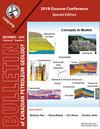西格陵兰Nuussuaq盆地非海相下白垩统至海相上白垩统沉积序列及古事件地层学
Q3 Earth and Planetary Sciences
引用次数: 18
摘要
Nuussuaq盆地是格陵兰岛西海岸唯一的中生代沉积地层。Nuussuaq盆地暴露出白垩纪和古新世的硅屑地层,被称为Nuussuaq群,上面覆盖着火山岩,主要是古新世的,被称为西格陵兰玄武岩群。区域地震研究表明,Nuussuaq盆地白垩系地层可能与近海盆地的Appat和Kangeq地震序列相关。本文重新研究了从Disko北部到Svartenhuk Halvo南部,大致呈东西走向的5条剖面,这些剖面是岩石和生物地层学的代表,重点研究了前坎帕尼亚沉积。最古老的暴露地层属于可能是阿拉伯纪时代的非海相Kome组。鞭毛囊肿表明半咸淡水条件是阿尔比尼亚和早期塞诺曼尼亚的特征,而海洋鞭毛囊肿出现在塞诺曼尼亚晚期和更年轻的沉积物中。Nuussuaq群的年代测定主要基于孢粉学,并有稀有的菊石支持。通过对许多新剖面和旧剖面的研究,建立了一套新的、精细的粉孢事件地层学。新的古成岩事件地层学可以更好地对比大间距的陆上剖面和海上序列,并为古地理解释提供了更好的基础。本文章由计算机程序翻译,如有差异,请以英文原文为准。
Sedimentary successions and palynoevent stratigraphy from the non-marine Lower Cretaceous to the marine Upper Cretaceous of the Nuussuaq Basin, West Greenland
Abstract The Nuussuaq Basin, West Greenland, comprises the only exposures of Mesozoic sedimentary strata on the west coast of Greenland. The Nuussuaq Basin exposes Cretaceous and Paleocene siliciclastic strata, referred to as the Nuussuaq Group, overlain by volcanic rocks, mainly of Paleocene age, referred to as the West Greenland Basalt Group. Regional seismic studies indicate that the Cretaceous strata of the Nuussuaq Basin may be correlated to the Appat and Kangeq seismic sequences in the offshore basins. The present paper re-investigates five profiles, trending roughly east-west, from northern Disko to southern Svartenhuk Halvo, which exemplify the litho- and biostratigraphy, with a focus on the pre-Campanian deposits. The oldest exposed strata belong to the non-marine Kome Formation of possible Albian age. Dinoflagellate cysts that indicate brackish water conditions characterize the Albian and early Cenomanian, whereas marine dinoflagellate cysts occur in the latest Cenomanian, and in younger deposits. The dating of the Nuussuaq Group is based mostly on palynology, supported by scarce ammonites. A new, refined palynoevent stratigraphy is established, based on the study of many new and older sections. The new palynoevent stratigraphy allows a better correlation between widely spaced onshore sections and offshore successions, and provides an improved basis for paleogeographical interpretations.
求助全文
通过发布文献求助,成功后即可免费获取论文全文。
去求助
来源期刊

Bullentin of Canadian Petroleum Geology
Earth and Planetary Sciences-Geochemistry and Petrology
CiteScore
2.50
自引率
0.00%
发文量
0
期刊介绍:
The Bulletin of Canadian Petroleum Geology is a peer-reviewed scientific journal published four times a year. Founded in 1953, the BCPG aims to be the journal of record for papers dealing with all aspects of petroleum geology, broadly conceived, with a particularly (though not exclusively) Canadian focus. International submissions are encouraged, especially where a connection can be made to Canadian examples.
 求助内容:
求助内容: 应助结果提醒方式:
应助结果提醒方式:


